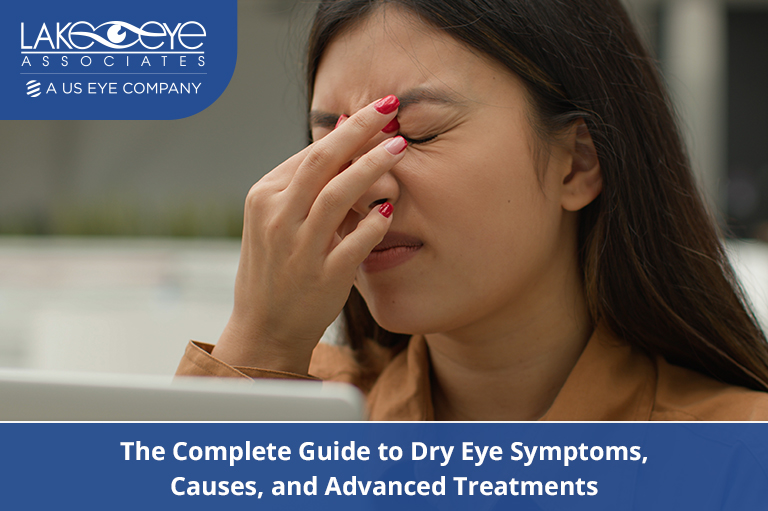Reviewed By: Dr. Christine Bui, OD
Do your eyes often feel gritty, sting, or burn after long hours at the computer or in windy weather? Perhaps your vision gets blurry, or you struggle to wear contact lenses comfortably. These are hallmark symptoms of dry eye syndrome—a condition that affects over 16 million Americans officially and millions more who remain undiagnosed.
Tears are far more complex than they seem. They consist of three critical layers, each serving a distinct role in maintaining eye health and clear vision. Left untreated, dry eye can disrupt this balance and lead to uncomfortable symptoms. But can dry eyes cause vision problems? Absolutely—it can impair your ability to see clearly and even affect daily activities like reading or driving.
Let’s dive into the science of dry eye syndrome and explore the most effective dry eye therapy solutions.
The Science of Tears: Why They Matter
Tears play a vital role in protecting your eyes and ensuring optimal vision. They are composed of three layers that work together to hydrate and protect your eyes:
- Oily Layer: The outermost layer, produced by the meibomian glands, prevents tears from evaporating too quickly.
- Watery Layer: Created by the lacrimal glands, this layer washes away debris and keeps your eyes clean.
- Mucus Layer: The conjunctiva’s innermost layer helps tears spread evenly over the eye’s surface.
When even one of these layers is compromised, you may experience dryness, irritation, or even excessive tearing as your eyes struggle to compensate for the imbalance. This delicate system underscores why personalized dry eye therapy is so important.
Common Dry Eye Symptoms
Dry eye symptoms can vary, but the most common include:
- Burning or stinging sensations in the eyes.
- Grittiness, as if something is stuck in your eye.
- Redness and irritation are often worsened by wind or smoke.
- Blurred vision that worsens after screen use or reading.
- Discomfort with contact lenses.
- Excessive tearing, paradoxically caused by irritation.
If you’re experiencing any of these symptoms, consult a dry eye specialist to identify the root cause.
What Causes Dry Eye Syndrome?
Dry eye syndrome can stem from various factors, including:
- Aging and Hormonal Changes: Tear production diminishes with age, particularly in post-menopausal women.
- Medical Conditions: Autoimmune diseases like Sjögren’s syndrome, rheumatoid arthritis, and thyroid disorders can disrupt tear production.
- Environmental Triggers: Dry climates, excessive wind exposure, and prolonged screen use decrease blinking rates, exacerbating dryness.
- Medications: Antihistamines, antidepressants, diuretics, and other drugs can interfere with tear production.
- Eye Surgeries: Procedures like LASIK can temporarily affect tear production.
How Is Dry Eye Diagnosed?
A thorough eye examination by a dry eye ophthalmologist helps diagnose the syndrome and determine the best treatment plan. You can typically expect tear quality and production tests and an eyelid health evaluation during your exam. Doctors also use specialized diagnostic tools like tear film analysis or tear breakup time measurements to provide detailed insights to craft a therapy plan.
Dry Eye Therapy Treatment Options
Artificial Tears
Over-the-counter artificial tears can provide temporary relief. If you need them frequently, preservative-free versions are gentler on your eyes.
Punctal Plugs
These small, biocompatible plugs are inserted into tear ducts to reduce tear drainage, keeping your eyes moist for longer periods.
Prescription Medications
Certain medicated eye drops, like cyclosporine (Restasis) or lifitegrast (Xiidra), stimulate natural tear production and address inflammation.
Eyelid Treatments
Warm Compresses relieve meibomian gland blockages, and lid hygiene products like specialized cleansers reduce inflammation and promote healthy tear production.
Advanced Therapies
Intense Pulsed Light (IPL) targets meibomian gland dysfunction, and LipiFlow®, a thermal pulsation treatment, unclogs oil glands in the eyelids.

The Best Eye Care Routine for Dry Eyes
Building a daily routine tailored to dry eye relief can work wonders for your comfort and long-term eye health. Here’s what the best eye care routine for dry eyes might look like:
- Start your day by applying a preservative-free artificial tear to refresh your eyes.
- Every 20 minutes, look at an object 20 feet away for 20 seconds to reduce screen-related strain.
- Clean your eyelids gently with a hypoallergenic cleanser to remove debris and excess oil.
- Apply an overnight eye ointment or gel to keep your eyes hydrated while you sleep.
- Drink plenty of water to support tear production.
- Use a humidifier during dry seasons to maintain moisture levels in the air.
- Wear wrap-around sunglasses to shield your eyes from wind, dust, and UV rays.
Final Notes
Your eyes are more than windows to the world—they’re how you connect, work, play, and live fully. Yet, when dry eye syndrome takes hold, it can feel like an invisible barrier to the life you deserve. Blurry screens, gritty mornings, and burning afternoons don’t have to be your new normal.
Lake Eye Associates offers personalized dry eye solutions at six convenient locations across Florida, making it easier than ever to get the care you need. Schedule your consultation now and step into a life of clearer vision and lasting comfort.
**The content of this blog is intended for general informational purposes only and is not a substitute for professional medical advice, diagnosis, or treatment. It may not address your specific eye health concerns, vision correction needs, or insurance considerations. Always consult a qualified eye care professional to explore treatment options and receive personalized guidance tailored to your unique situation.**






